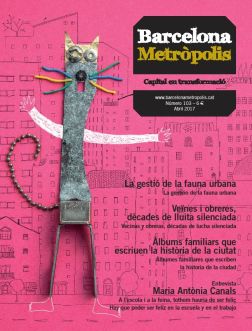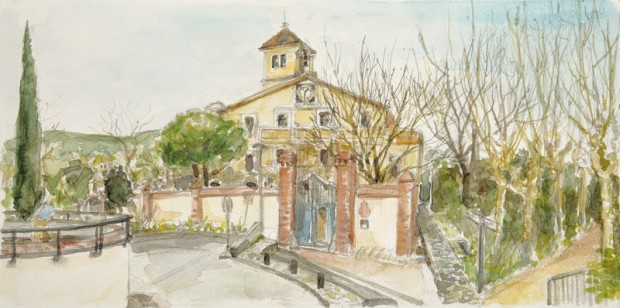Vallvidrera is a small area independent of the city and, yet, as barcelonian comme il faut.
I suspect that Jane Bowles, Pere Calders, Nelly Sachs, Joan Maragall, Federico García Lorca, Josep Vicenç Foix and Mercè Rodoreda once lived together in Vallvidrera. I imagine them in a big, rickety old house on Carrer de Queralt, overlooking the sea at the front and Plaça de Pep Ventura, famed for his work with the sardana, waltz, quadrille and mazurka dances, at the back. I imagine them in an elegant, humid garden, facing the city and perhaps having discussions, but quickly embracing one another and exchanging bundles of artichokes from Crespo and some cumin bread. I picture them in Can Trampa with a small piece of mud, like the ones they have at La Mandarina in among the newspapers, slippers, geraniums and skeins. Grabbing soil to mark the proposal and the hands of the Gypsy Ballads, of the burning enigmas, of the shadow of the agave, of the Perris star, of however many wars, of small pleasures and sequences. I think of them chasing the Gamberro Infinit down to the Revolt de les Monges (the spot where the nuns were murdered). If they did go, it must have been because of the healing powers of horsetail: the plant is hidden around there. Or perhaps because it is a medicinal herb and a weed all at the same time and because mixtures always turn out well: just like this neighbourhood of Vallvidrera, a small area independent of the city and, yet, as barcelonian comme il faut. It is as proud as the sunshine (they know the privileged position of the hillside), values its balconies and its simply sophisticated modernism, renounces the military parades that marched along the Carretera de les Aigües, has tiger mosquitos and wild boars, has exchange markets and has managed to establish an organic food cooperative, with a Condis supermarket and a colmado [in Spain, an independent grocer’s shop and delicatessen], so there is enough to see and do. It has an abandoned broken-down market, a house that serves as a theatre for children, a choir, a nursery, the Nabí primary school, a therapeutic centre for I can’t remember what, a tobacconist and two estate agents (that never fail). There is also a depressing church next to the hairdressers and I don’t know if anyone goes there (I’ve never seen anyone go in).
Vallvidrera – where buses that have struggled to arrive welcome strangers with a small degree of suspicion, but they welcome them all the same. The star of the show is the Josep Miracle library and the Civic Centre. They are so brave and beautiful that they serve as the town square — from where you can see, oh what joy, Montserrat and everything that entails. Children and more children make sandcastles and get into fights because they knocked them over and they help each other because they know how. Men and women study English, do yoga and capoeira and attend conferences on emotional education and limits. One day, some, but not many, form a circle around the Xarxa d’Escoles Insubmises (the rebellious schools network), that my own dear Laia organises. Perhaps the writers went down to Carretera de l’Església, which becomes Carretera Vallvidrera more or less by les Planes and is joined by Camí de la Llenega and Camí del Salze. There, the bend that marks the spot where five nuns were murdered during the Spanish Civil War, leads easily to Els Xiprers school and Vil·la Joana, which is where he who felt the presence of the devil,and knowing that he would have to fall out with the world in order to value it, lived and died. Or because, a little higher up and further on, is the Font de la Budellera, with its name that dazzles with fear. If they went there, they must surely have felt tired and gone for a soak in the republican pool at La Floresta. Who knows whether afterwards they ate seitan with Tamazight batucada at la Floresteca on Plaça de Miquel Ros, grilled lamb with sky blue oil and alioli at Can Pichurri or something delicious in Sant Cugat. The thing is that, be they punk or rich, hippy or cool, everyone eats lunch. It’s good to know, lest we stop valuing the state schools that we can attend, the efficiency of our healthcare centre and the love on which La Puput early years’ nursery operates.
I suspect that, before living together in the trolley at the recycling facility in Vallvidrera, Jane Bowles, Pere Calders, Nelly Sachs, Joan Maragall, Federico García Lorca, Josep Vicenç Foix and Mercè Rodoreda lived together on the same shelf in the same house. If it’s you, oh generous reader, who is sharing your books, then thank you very much.




